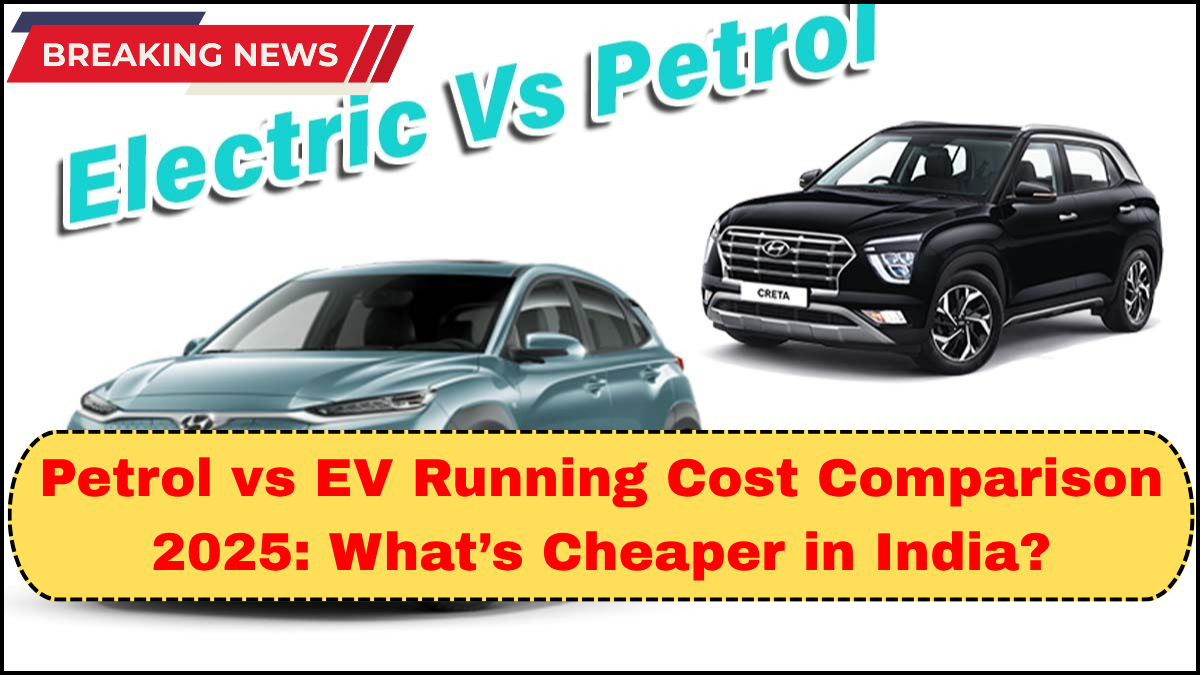As India accelerates toward cleaner mobility, the debate intensifies between traditional petrol-powered vehicles and electric vehicles (EVs). One of the most crucial aspects influencing consumer decisions is the running cost. In 2025, the Petrol vs EV running cost comparison is more relevant than ever, especially as fuel prices rise and EV adoption gains momentum.

Let’s break down the actual cost dynamics in India to determine which option makes more financial sense today.
Understanding Running Costs: What Are We Comparing?
Running cost refers to the daily operational expenses of a vehicle — fuel or electricity, maintenance, servicing, and repairs. Initial purchase cost is important, but it’s the long-term expenses that hit your wallet monthly.
To make a fair cost comparison for India cars, let’s consider a mid-range hatchback in both petrol and electric variants, with an average usage of 1,200 km per month.
Fuel vs Electricity: Price Breakdown in 2025
-
Petrol Price in 2025 (India Average): ₹105–₹115 per litre
-
Electricity Tariff (Home Charging): ₹6–₹8 per kWh
-
Electricity Tariff (Fast Public Charging): ₹15–₹20 per kWh
Example:
-
A petrol car giving 17 km/l will consume about 70 litres/month = ₹7,350 (@₹105/l)
-
An EV consuming 0.15 kWh/km for 1,200 km will need 180 kWh = ₹1,260 (@₹7/kWh home charging)
Result: Petrol vehicle costs 5.8x more in fuel than an EV charged at home.
Maintenance and Service Costs
Petrol Vehicles
-
Engine oil changes, filter replacements, spark plugs, belts, and regular servicing.
-
Average annual maintenance: ₹12,000–₹18,000
Electric Vehicles
-
No engine oil, fewer moving parts, regenerative braking reduces wear and tear.
-
Average annual maintenance: ₹5,000–₹8,000
Conclusion: EVs are cheaper to maintain by 50% or more.
Battery Replacement Costs: The Long-Term Catch?
One valid concern with EVs is battery degradation. However, most EV batteries come with an 8-year or 1.6 lakh km warranty. While replacing a battery may cost ₹3–₹6 lakh, advancements in battery tech and economies of scale are steadily bringing costs down. Most users won’t need a replacement during the average vehicle ownership period of 7–8 years.
Insurance Costs: Slightly Higher for EVs
-
EVs generally have higher insurance premiums due to their higher upfront cost.
-
However, the gap is narrowing as insurance providers launch EV-specific packages.
Charging Infrastructure and Convenience
EVs require accessible charging stations. As of 2025, India has made significant progress, especially in metro cities and highways with fast-charging networks. Home charging is the most cost-effective and convenient, but it requires dedicated parking space and setup costs (~₹15,000–₹25,000).
Petrol vehicles, on the other hand, have an established fuel network. But with rising fuel prices and stricter emission norms, their convenience is slowly losing appeal.
Total Monthly Running Cost Estimate (2025)
| Factor | Petrol Car (Monthly) | EV (Monthly – Home Charging) |
|---|---|---|
| Fuel/Electricity | ₹7,350 | ₹1,260 |
| Maintenance (Avg) | ₹1,200 | ₹600 |
| Insurance (Monthly Avg) | ₹900 | ₹1,100 |
| Total Cost | ₹9,450 | ₹2,960 |
Savings with EV: Approximately ₹6,500/month or ₹78,000/year
Government Incentives Boost EV Affordability
Under schemes like FAME II and state-level subsidies, buyers can get benefits worth ₹1–₹2.5 lakh, narrowing the price gap between petrol and electric models. Additionally, several states offer road tax waivers and registration fee exemptions for EVs.
Petrol vs EV Running Cost 2025: Final Verdict
When looking purely at Petrol vs EV running cost comparison in 2025, EVs are the clear winners in India. Despite higher upfront costs and occasional charging limitations, the long-term financial savings are substantial.
For urban commuters and fleet operators, EVs make undeniable economic sense. Petrol cars may still appeal in rural areas or for those with heavy highway use, but for most Indian consumers, the shift to electric is both practical and profitable.
FAQs
1. Are EVs really cheaper to run than petrol cars in India?
Yes. EVs cost significantly less in electricity and maintenance. Over 5 years, an average EV owner could save over ₹3–₹4 lakhs in running costs compared to a petrol vehicle.
2. What about battery replacement costs?
While expensive, most EVs won’t need a battery replacement within the typical ownership period. Warranties cover up to 8 years or 1.6 lakh km.
3. Do EVs work well outside metro cities?
Yes, especially if you charge at home. Public charging is expanding in Tier 2 and Tier 3 cities, but infrastructure is still a work in progress in remote areas.
4. Are there any hidden costs with EVs?
Apart from the home charger installation and slightly higher insurance, there are no major hidden costs. In fact, fewer moving parts reduce the risk of unexpected breakdowns.
5. How long does it take to break even on an EV investment?
Typically 3–4 years, depending on usage. For high-mileage users like cab drivers, break-even may come even sooner.
click here to learn more